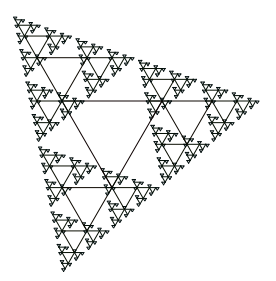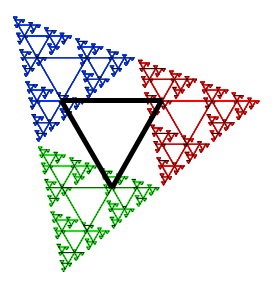Recursion Revisited
In this lab you will sort your contact list alphabetically by name.
On this page you will review the technique of recursion.
Recursive Graphics
A recursive problem (the thing you're trying to do, not the code to do it) is one in which the desired result includes a smaller version of itself, such as the green (or red or blue) fractal inside the bigger fractal. A recursive procedure (the actual code) is one that calls itself inside its definition. Do you see why a recursive procedure is likely to be a good solution to a recursive problem?
If a recursive procedure calls itself, and that call also calls itself, and that call also calls itself... the result will be an infinite loop, which means that the program will keep running forever (or until it runs out of memory). To avoid that bug, every recursive procedure must have a base case, a simple input for which the procedure can do its job without calling itself. (The base case of nested triangle happens when size ≤ 2; in that case the procedure doesn't have to do anything.)

Recursive Reporters
The general pattern for a recursive command is
![if (base case?) then [do something simple] else [[do something] [recursive call] [do something]]](/June2020bjc2/bjc-r/img/8-recursive-reporters/rec-command.png)
Compare this with the nested triangle block above. (In that one, the base case is particularly simple: it does nothing at all.) Most recursive commands follow this pattern, except that in certain cases there's more than one recursive call.
It's therefore tempting to try to write a recursive reporter this way:
![if (base case?) then [report something simple] else [[report something] [report recursive call] [report something]]](/June2020bjc2/bjc-r/img/8-recursive-reporters/bad-rec-reporter.png)
But in fact you can't stack report blocks; once your block reports a value, it's finished. (This is why there's no connection tab at the bottom of the report block.) Instead, you have to use a combiner function to put the pieces together into a single thing to report:
![if (base case?) then [report something simple] else [report (combiner (stuff) (recursive call) (stuff)]](/June2020bjc2/bjc-r/img/8-recursive-reporters/rec-reporter.png)
The combiner can be any function with the correct range (the kind of value it can return). So if your custom reporter is supposed to return a sentence, the combiner might be join or join words; if it's supposed to return a number, you might use + or ×.
- Write a reporter whose input is a list of numbers, reporting the sum of the numbers. Follow this template (without the comments):
![if (empty slot for test) [report (empty slot for value)] else [report (empty slot for value)]](/June2020bjc2/bjc-r/img/3-lists/sumof-framework.png)
If you'd like to write the sum of block with no additional help, do it now. Otherwise, fill in the three blanks in the definition this way:
- What should the base case test be? What's the smallest possible list of numbers? Fill in the hexagonal input slot in the
if block.
- What should your procedure report in that case? Super big hint if you can't get it to work.
The block is supposed to report a number.
-
What should your procedure report in the recursive case? You have to find a smaller, similar subproblem just as you did for the triangle fractal. Generally, when writing recursive blocks with lists as input, the most common idea is to split the list into its first item (
 ) and all the other items (
) and all the other items ( ).
).

and

are the main
selectors for lists.
- What are you going to do with
all but first of the list? You really don't need this hint.
What makes this a recursive procedure?
- How are you going to combine the first item with the result of part (i) to get the overall result?
Combining the items of a list is such a common thing to do that there's a higher order function for it.

-
Make friends with the
 block. Try these examples:
block. Try these examples:
Unlike map and keep, combine requires a function with two empty input slots.



Unlike its friends
map and
keep,
combine is mostly used with one of only these six functions in its first input slot:






Among blocks you might write yourself, there are only two likely candidates:

 Why so few?
Why so few?
The function has to be
associative, meaning that it doesn't matter what order you group the items in; (7 + 8) + 1 is the same as 7 + (8 + 1) (work it out yourself), but (7 − 8) − 1 is different from 7 − (8 − 1).
So

would be ambiguous.
-
Rewrite
sum of using combine.
So why'd you make us do it the hard way?
Well, for one thing, some people find recursion more natural than higher order functions. But also, the kinds of list reporter patterns that happen often enough in programs so that people have abstracted them into higher order functions tend to be the ones that are easiest to write recursively. On the next page you'll write a recursive operation for which there is no higher order function, but we wanted you to start with easier examples while getting to know how to write recursive reporters.
-
Build this block:

What does it do?
-
Now rewrite it using recursion instead of
map.
Selectors are all you needed for problem 6 because the reported result wasn't a list. If you want to write a recursive block that reports a list, you also need the
constructor 
, which makes a new list with one new item in front of an existing list.


![nested triangle, size: (size) : if (size > 2) [repeat 3 [set pen color to (color); move (size) steps; nested triangle, size: (size / 2) color: (color + 10); turn 120 degrees]]](/June2020bjc2/bjc-r/img/3-lists/nested-triangle.png) Get to know this code well:
Get to know this code well:

 makes two invocations of
makes two invocations of ![if (base case?) then [do something simple] else [[do something] [recursive call] [do something]]](/June2020bjc2/bjc-r/img/8-recursive-reporters/rec-command.png)
![if (base case?) then [report something simple] else [[report something] [report recursive call] [report something]]](/June2020bjc2/bjc-r/img/8-recursive-reporters/bad-rec-reporter.png)
![if (base case?) then [report something simple] else [report (combiner (stuff) (recursive call) (stuff)]](/June2020bjc2/bjc-r/img/8-recursive-reporters/rec-reporter.png)
![if (empty slot for test) [report (empty slot for value)] else [report (empty slot for value)]](/June2020bjc2/bjc-r/img/3-lists/sumof-framework.png)
 ) and all the other items (
) and all the other items ( ).
).
 block. Try these examples:
block. Try these examples:










 would be ambiguous.
would be ambiguous.

 , which makes a new list with one new item in front of an existing list.
, which makes a new list with one new item in front of an existing list.

 (pronounced "sentence to list"). It lets you break a string at every space and convert the string to a list of words. It's in the Tools library.
(pronounced "sentence to list"). It lets you break a string at every space and convert the string to a list of words. It's in the Tools library.